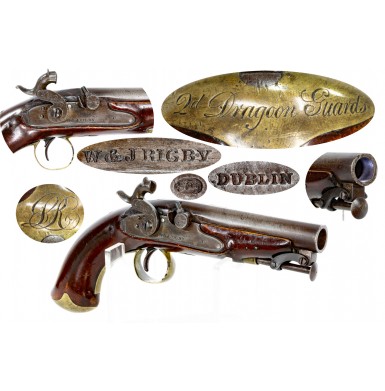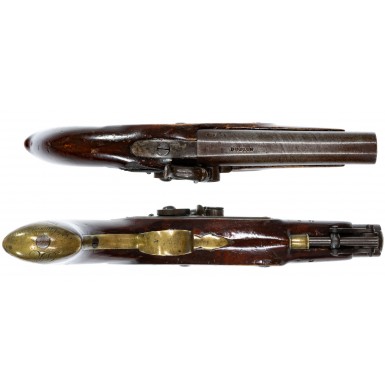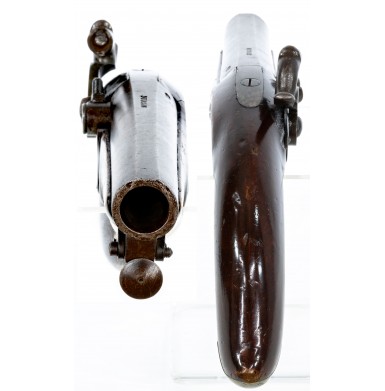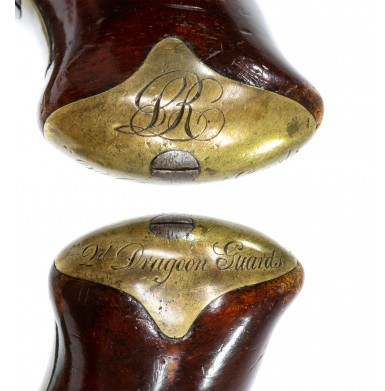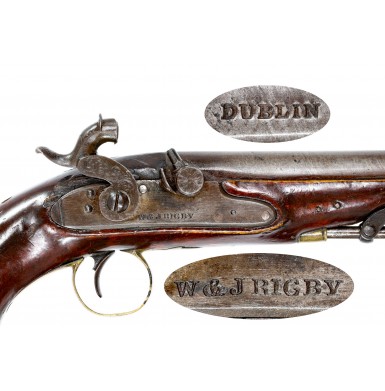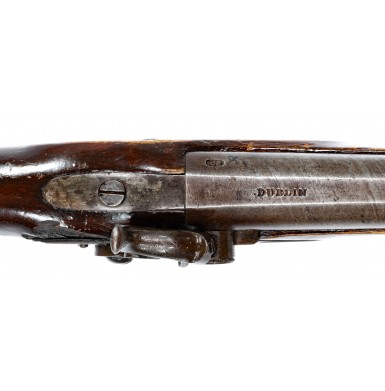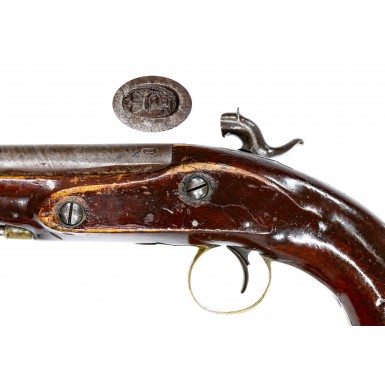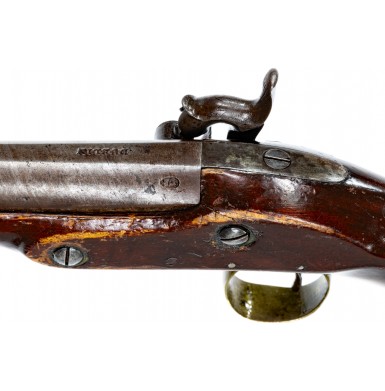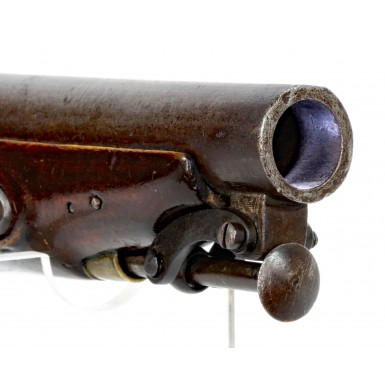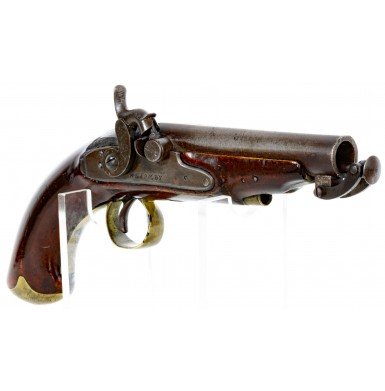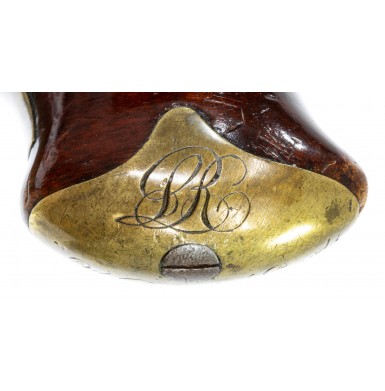2nd Dragoon Guards Marked Percussion Coat Pistol by Rigby of Dublin
- Product Code: FHG-3497-SOLD
- Availability: Out Of Stock
-
$2,495.00
This is a lovely example of a private purchase Irish-made Percussion Overcoat Pistol marked to the 2nd Dragoon Guards and made by the famous firm of W & J Rigby of Dublin. The pistol is clearly marked on the lock in a single line, forward of the hammer: W & J Rigby and the top of the barrel is stamped DUBLIN with a {CROWN} / P proof at the left breech quadrant.
The firm of John Rigby & Company was established in Dublin, Ireland in 1775. In 1816 the “second” John Rigby joined the firm and in 1818 the company was known as William & John Rigby, with that branch of the business remaining in Dublin until 1892. At that time Trulock & Harris acquired the Irish portion of the business, which subsequently closed its doors in 1897. In 1851 John Rigby III displayed much of his work at the Great Exhibition in London and in 1858 began collaborations with Joseph Needham in the design of self-contained cartridge firearms. It would be John Rigby III who would be responsible for the world-renowned fame of the Rigby name when associated with firearms. In 1866 John Rigby III established John Rigby & Company at 72 St. James Street in London, where the firm remained until 1907, at which time they relocated 43 Sackville Street. In 1900 the firm was renamed John Rigby & Co LTD. During the early 1870s Rigby concentrated his design efforts on producing high quality match rifles, as well as working on designs to improve and enhance cartridge firearms, especially double rifles for big game hunting. In 1879 Rigby debuted his “Rising Bite”series of big game double guns that remain in production to this day. In fact, if you would like to order a Rigby Rising Bite (only available in .470 or .500 Nitro Express), be prepared to wait at least three years. You should also be prepared for the price, as the guns start at £95,000 (about $145,000 US) and go up from there. In 1887 Rigby was appointed the Superintendent of the Royal Small Arms Factory at Enfield Lock (RSAF), where he would continue to advance gun designs, and would collaborate with Paul Mauser in 1897 to develop the Mauser “Magnum” bolt action, which remains one of the strongest and most reliable actions for high powered cartridges to this day. Over the next decade Rigby would develop some of the most powerful big game cartridges ever produced, including the .450 Nitro Express (1898), the .350 No 2 and .350 Magnum (1908) and the world famous .416 Rigby (1911). John Rigby III died in 1916, but his name and the family business live on, with the company eventually bought by a series of investment groups that finally reunited the Rigby and Mauser names in 2103 after 100 years.
The more infesting set of markings on the pistol are engraved on the bottom portion of the lobed brass buttcap. The obverse of the cap reads 2nd Dragoon Guards, and the reverse is the intertwined script monogram cypher for an unknown member of the 2nd Dragoon Guards who was likely an officer.
The 2nd Dragoon Guards was one of the oldest and most storied cavalry regiments in English service. The regiment was initially raised in June of 1685 s the Earl of Peterborough’s Regiment of Horse to fight on the side of King James II against the Earl of Monmouth’s rebellion. The regiment was formed from four troops of independent cavalry that had been raised in Hounslow, Edgeware, London, and Yorkshire. However, three years later the regiment fought against the crown, supporting William III against James. The regiment fought at Boyne (1690) and Aughrim in Ireland (1691) and was a major component in securing a victory at that battle by joining the Royal Horse Guards in a battle winning charge. The regiment spent the majority of the latter part of the 1690s fighting in support of William in the Low Countries. The regiment fought during the War of the Spanish Succession (1701-1714) and was engaged in such battles as Almanza (1707), Almenar (1710) and Brihuega (1710). Most of the regiment was captured at this last battle but was later released via a prisoner exchange. During the period of 1714-1715 the regiment fought against the Jacobites during that rebellion, after which they were officially designated as “Dragoon Guards”. Over the next few decades, the regiment received at least three new names, including The Princess of Wales’s Dragoon Guards, The Queen’s Own Dragoon Guards and finally the 2nd (The Queen’s) Regiment of Dragoon Guards in 1751.
The regiment fought during the Seven Years War (1756-1763) and was engaged at Corbach and Warburg (1760) and Wilhelmsthal (1762). In 1763 the regiment returned to England to suppress riots. In 1767 the regimental custom of riding only Bay colored horses was incorporated into their official title as the 2nd Dragoon Guard (Queen’s Bays). The regiment fought in France during the French Revolutionary Wars (1793-1802) and was engaged at Valenciennes and Dunkirk (1793), returning to England in 1795. The regiment spent the next decade in England but was present at Waterloo in 1815. The next four decades were spent either in England or on garrison duty around the British Empire, including service in India and Ireland. The regiment returned to India for the Indian Mutiny in 1857 and also fought in South Africa during the Boer War (1899-1902), where it was heavily mauled at Leeuwkop (1902).
Like any British regiment, the 2nd Dragoon Guards saw extensive service in France during World War I and fought during the Retreat from Mons, at Le Cateau, the Marne and Ypres during 1914. Other major actions including the Somme (1916), Arras and Cambrai (1917) and the Scarpe (1918). In 1921 the regiment was renamed the Queen’s Bays (2nd Dragoon Guards) and saw service in a variety of postings around the British Empire. In 1937 became a mechanized regiment that served in light tanks, and they became part of the Royal Armored Corps in 1939. The regiment was active during World War II fighting in France during May and June 1940 prior to the British evacuation. The regiment was then deployed to North Africa where it fought at Gazala, and both Battles of Alamein in 1942. They participated in the Tunisian Campaign in 1943 and then moved to Italy in May 1944, fighting at the Battle of Argenta Gap in 1945. The regiment’s post World War II duty included occupation service in Germany through 1948 and three years of peace keeping in Libya and Jordan from 1954-1957. In 1959 the regiment was merged with the 1st King’s Dragoon Guards to form the 1st Queen’s Dragoon Guards.
The part of the regiment’s history that pertains to this pistol is their use as domestic peacekeepers during the 1840s. In 1842 the Chartist Disturbances resulted in rioting and great civil unrest and the 2nd Dragoon Guards spent much of that year in Cheshire and Staffordshire keeping the peace. Sometimes this meant charging rioters with drawn swords. In 1843 the regiment was sent to Ireland for a five-year tour as peacekeepers. The 1842 Chartist Disturbances had manifested themselves in Ireland in the form of the Young Ireland movement. This movement had erupted around much of the world, particularly in Europe where the peasant and tenant farmer classes were starting to struggle for independence and democratic reforms to free them from the power of their overlords and the property owners. In Ireland the movement was fueled by the long-standing rifts between Catholics and Protestants, Unionists and Home Rule supporters and in 1845 by the outbreak of the Potato Famine. The famine would ravage the country for the next few years and would result in thousands of deaths and the first mass immigration of the Irish to America. It was into this volatile situation the 2ndDragoon Guards was thrown to maintain order, execute evictions of tenants in arrears and try to keep the lid on a powder keg of civil unrest. The British soldiers were universally despised by the Catholics and Home Rule supporters and were certainly not welcome. It would have been unwise for any British soldier to go about much of country unarmed at any time. However, there were certainly situations where openly carrying arms would have done little more than inflame the passions of the locals. As such, a concealable pistol was just the answer for British officer who might have responsibilities and duties that took him away from the regiment’s primary camp or away from the support of his troopers. I am firmly convinced that this pistol was likely one of a pair carried by just such an officer in the 2nd Dragoon Guards during their service in Ireland from 1843-1848.
The percussion coat pistol is nominally 10 ½” in overall length with a 5” round barrel that has an extended nocksform (breech flat) that runs the entire length of the barrel. The bore is nominally .66 caliber, making the pistol “carbine bore” in the terms of the English military system for establishing caliber during that period. That meant the pistol would take the same size ball as a military carbine of the period. The gun could be referred to as a “Constabulary Pistol” and certainly shows some similarities to those guns, a “Goal Warder’s Pistol” and again is similar to those guns, and even shows some similarities to the pistols used by the Revenue Service and Coast Guard of the period. In reality all of those are simply a civilian style percussion overcoat pistols that have a “military” appearance. In this case it is due to the lobed butt cap that brings to mind the New Land Pattern pistols that were being phased out or altered to percussion during the 1840s. The pistol has a captive ramrod, a common military feature of the period as well. The lock is a standard civilian type percussion pistol lock with a stepped tail that is retained with a pair of screws with sidenail cups and does not have a side plate. The hammer is also of a civilian pattern, as is the drum bolster. Both are lightly engraved. The brass furniture, which other than the buttcap consists of only the triggerguard, entry pipe and sidenail cups (lock screw escutcheons) would be equally at home on a civilian or military pistol of the period.
The pistol remains in VERY GOOD+ to NEAR FINE condition. The barrel retains some strong traces of the original browned finish with the Damascus patterning on the barrel remaining quite visible. The lock retains very strong traces of the original case coloring, which is strongest in the center of the lock. The lock remains mechanically functional and works as it should. The screw-in drum bolster is somewhat loose and can be rotated in the touchhole. The smooth bore of the pistol is in about VERY GOOD condition and shows moderate oxidation and some scattered light pitting. The captive swivel ramrod remains intact and fully functional as well. The brass has a lovely, untouched, and uncleaned ocher patina. The wood shows some light to moderate wear, with finish loss along the high edges and contact point but retains good edges with no indications of having been sanded. The wood shows scattered bumps, dings and mars and a couple of minor cracks in the counterpane. The more obvious extends from the rear lock screw to the barrel channel, and a spidering surface grain crack is visible on the counterpane as well. A chip of wood is missing from the upper rear of the lock mortise area, between the lock plate and the breech plug tang. Otherwise, the wood remains solid and shows the type of wear consistent with a pistol that was carried a lot, most likely concealed in a coat pocket.
Overall, this is a very attractive and interesting pistol that is steeped in the history and turmoil of mid-19th century Ireland and represents the danger faced by British soldiers who were deployed there during that time. The gun was made by the famous Rigby firm and is marked to one of the most historic regiments in British service, one that has over four hundred years of history.
SOLD
Tags: 2nd, Dragoon, Guards, Marked, Percussion, Coat, Pistol, by, Rigby, of, Dublin

